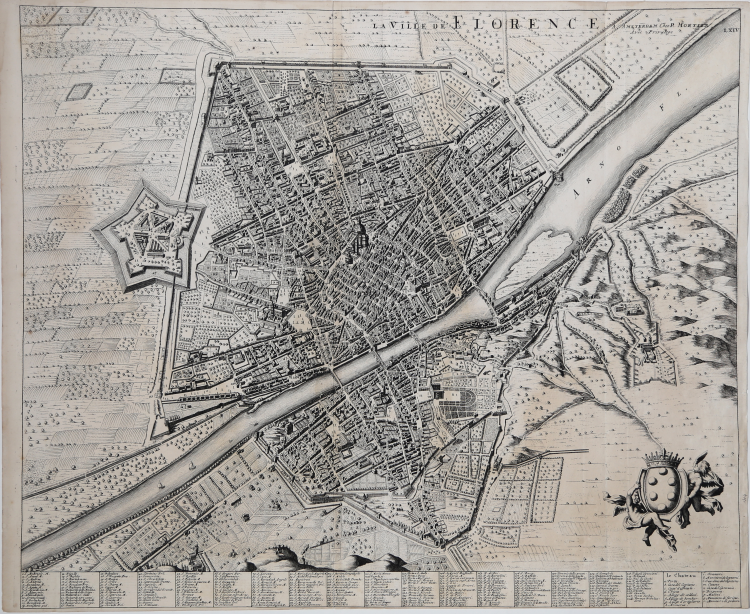



| Reference: | s29396 |
| Author | Pierre MORTIER |
| Year: | 1704 ca. |
| Zone: | Florence |
| Printed: | Amsterdam |
| Measures: | 610 x 510 mm |


| Reference: | s29396 |
| Author | Pierre MORTIER |
| Year: | 1704 ca. |
| Zone: | Florence |
| Printed: | Amsterdam |
| Measures: | 610 x 510 mm |
Beatiful map of Florence taken from the "Nouveau Theatre d'Italie", published between 1704/05. The prototype of this work is the view engraved by Hollar, after Bonsignori, and published in 1660.The Duomo stands out prominently at the center of the map, while the Arno river cuts diagonally across the map, creating dynamism.
The town's star-shaped fort, known as the Fortress da Basso or Fortress of San Giovanni Battista, is prominent at the left edge of the map. On the left side, is prominent the Fortezza da Basso. After all, a legend with over 200 places of interest. In the right corner, is represented Medici coat of arms.
Copper engraving, in excellent condition.
|
Pieter and David Mortier were brothers of French extraction whose publishing interests covered a wide field embracing French and English works as well as Dutch.
Pieter was probably trained in the bookselling business in Paris and David spent many years in England; in fact, he acquired British nationality and died there in about 1728.
After Pieter's death, his widow continued the business until their son, Cornelis, was able to take over; then, in 1721, Cornelis entered into partnership with his brother-in-law, Johannes Covens, to form the famous name Covens and Mortier, a firm which existed, with slight change of name, until the middle of the nineteenth century.
Under the heading Pieter Mortier we give some details of the extensive publishing business which he built up in Amsterdam and which, after his death, was subsequently taken over by his son, the above-named Cornelis.
In 1721 Cornelis married the sister of Johannes Covens and in the same year he and Johannes entered into partnership as publishers under the name Covens and Mortier which, with its successors, became one of the most important firms in the Dutch map publishing business.
Their prolific output over the years included reissues of general atlases by Sanson, Jaillot, Delisle, Visscher, de Wit (whose stock they acquired) and others (often with re-engraved maps), atlases of particular countries including Germany, England and Scotland and others in Europe, pocket atlases, town plans and, from about 1730 onwards, a series under the title Nieuwe Atlas, some consisting of as many as 900 maps by various cartographers and publishers. As there is no conformity about these volumes they were presumably made up to special order and only general details of publication can be quoted in a work of this size.
|
|
Pieter and David Mortier were brothers of French extraction whose publishing interests covered a wide field embracing French and English works as well as Dutch.
Pieter was probably trained in the bookselling business in Paris and David spent many years in England; in fact, he acquired British nationality and died there in about 1728.
After Pieter's death, his widow continued the business until their son, Cornelis, was able to take over; then, in 1721, Cornelis entered into partnership with his brother-in-law, Johannes Covens, to form the famous name Covens and Mortier, a firm which existed, with slight change of name, until the middle of the nineteenth century.
Under the heading Pieter Mortier we give some details of the extensive publishing business which he built up in Amsterdam and which, after his death, was subsequently taken over by his son, the above-named Cornelis.
In 1721 Cornelis married the sister of Johannes Covens and in the same year he and Johannes entered into partnership as publishers under the name Covens and Mortier which, with its successors, became one of the most important firms in the Dutch map publishing business.
Their prolific output over the years included reissues of general atlases by Sanson, Jaillot, Delisle, Visscher, de Wit (whose stock they acquired) and others (often with re-engraved maps), atlases of particular countries including Germany, England and Scotland and others in Europe, pocket atlases, town plans and, from about 1730 onwards, a series under the title Nieuwe Atlas, some consisting of as many as 900 maps by various cartographers and publishers. As there is no conformity about these volumes they were presumably made up to special order and only general details of publication can be quoted in a work of this size.
|